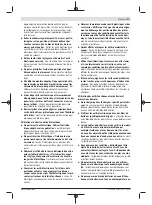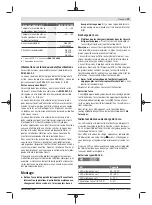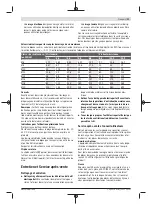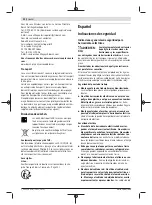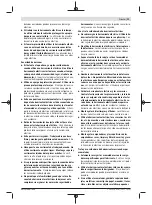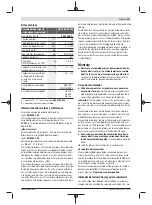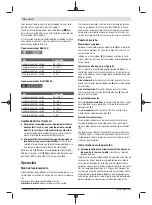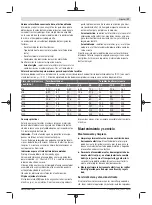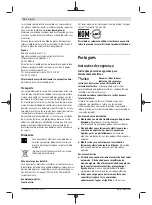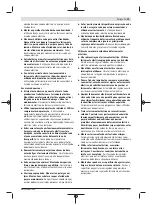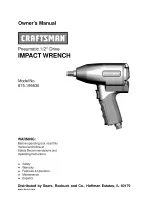
14
| English
If no LED lights up after pressing the button for the battery
charge indicator, then the battery is defective and must be
replaced.
Battery model GBA 18V...
LEDs
Capacity
3× continuous green light
60−100 %
2× continuous green light
30−60 %
1× continuous green light
5−30 %
1× flashing green light
0−5 %
Battery model ProCORE18V...
LEDs
Capacity
5× continuous green light
80−100 %
4× continuous green light
60−80 %
3× continuous green light
40−60 %
2× continuous green light
20−40 %
1× continuous green light
5−20 %
1× flashing green light
0−5 %
Changing the tool (see figure A)
u
Remove the battery from the power tool before carry-
ing out work on the power tool (e.g. maintenance,
changing tool, etc.). The battery should also be re-
moved for transport and storage.
There is risk of injury
from unintentionally pressing the on/off switch.
u
When working with an application tool, pay attention
that the application tool is connected securely to the
tool holder.
When the application tool is not securely
connected with the tool holder, it can come off during ap-
plication.
Slide the application tool
(10)
onto the square drive of the
tool holder
(1)
.
Due to the way the system operates, the application tool
(10)
will move around slightly in the tool holder
(1)
; this has
no influence on the function/safety.
Operation
Method of Operation
The tool holder
(1)
(with the application tool) is driven by an
electric motor via a gear and impact mechanism.
The working procedure is divided into two phases:
Screwing in
and
tightening
(impact mechanism in action).
The impact mechanism is activated as soon as the screwed
connection runs tight and load is therefore put on the motor.
The impact mechanism then converts the power of the mo-
tor to steady rotary impacts. When loosening screws or nuts,
the process is reversed.
Starting Operation
Inserting the battery
Set the rotational direction switch
(6)
to the centre position
to protect the power tool from being switched on accident-
ally.
Push the charged battery
(4)
into the base of the power tool
until the battery is securely locked.
Set the rotational direction (see figure B)
The rotational direction switch
(6)
is used to change the ro-
tational direction of the power tool. However, this is not pos-
sible while the on/off switch
(7)
is being pressed.
Right rotation:
To drive in screws and tighten nuts, press
the rotational direction switch
(6)
through to the left stop.
Left Rotation:
To loosen and unscrew screws and nuts,
press the rotational direction switch
(6)
through to the right
stop.
Switching on/off
To
start
the power tool, press and hold the on/off switch
(7)
.
To
switch off
the power tool, release the on/off switch
(7)
.
Adjusting the Speed
You can adjust the speed of the power tool when it is on by
pressing in the on/off switch
(7)
to varying extents.
A light pressure on the on/off switch
(7)
results in a low rota-
tional speed. Increased pressure on the switch causes an in-
crease in speed.
Practical advice
u
Only apply the power tool to the screw/nut when the
tool is switched off.
Rotating tool inserts can slip off.
The torque depends on the impact duration. The maximum
achieved torque results from the sum of all individual
torques achieved through impact. Maximum torque is
achieved after an impact duration of 6–10 seconds. After
this duration, the tightening torque increases only minimally.
The impact duration is to be determined for each required
tightening torque. The tightening torque actually achieved
should always be checked with a torque wrench.
Screw applications with hard, spring-loaded or soft seats
When the achieved torques in an impact series are measured
during a test and transferred onto a diagram, the result is the
curve of a torque characteristic. The height of the curve cor-
responds to the maximum achievable torque, and the steep-
ness indicates the duration in which this is achieved.
A torque characteristic depends on the following factors:
– Strength properties of the screws/nuts
– Type of backing (washer, disc spring, seal)
– Strength properties of the material being screwed/bolted
together
– Lubrication conditions at the screw/bolt connection
1 609 92A 4PN | (16.11.2020)
Bosch Power Tools

















